Crushing It: Can Ground-Up Rock Help Save the Earth?
Scientists are hard at work studying the potential of enhanced weathering to store carbon. But environmental start-ups aren’t waiting for the full report.

Nature perfected the carbon cycle a long time ago, and rock weathering plays a key role by helping capture atmospheric carbon dioxide through a chemical reaction that occurs when silicate rocks are exposed to air and water. Crushing up the right kind of rocks and spreading them on land could help humans ratchet up nature’s process significantly, capturing some of the excess carbon dioxide we’ve released into the atmosphere. The promising idea has attracted not only a growing number of scientists, but also environmental entrepreneurs who are turning the research into action, albeit at a pace not everyone is comfortable with. While the scientific and business approaches operate under different rules, there’s room for cooperation, data sharing, and innovation as they target the common enemy of climate change.
For millennia, when it came to maintaining the planet’s carbon cycle, the earth was rocking it— literally. After volcanic and other natural processes released earth-bound carbon into the atmosphere, carbon dioxide dissolved into rainwater to form a weak acid. In a process called weathering, that acid interacted chemically with rocks in a way that eventually locked up the carbon way down at the bottom of the sea floor.
Of course, we know by now how we messed that all up. Today, legions of scientists, environmentalists, policymakers, and business owners are working on ways to capture enough of the excess carbon in our atmosphere to escape the worst of climate change. One of those carbon dioxide removal (CDR) ideas calls for turning nature’s time-honored weathering process up a notch, or two, or three—or even many more, according to some estimates.
Called enhanced weathering (EW), the technique involves crushing up massive amounts of rock, transporting them to farms (ideally nearby), and spreading them across fields. Because a pile of rock powder offers precipitation far more surface area than would a group of boulders, much more carbon can be captured. Planet-wide, natural weathering removes about half a billion tons of carbon from the atmosphere annually, says Ben Houlton, dean of Cornell University’s College of Agriculture and Life Sciences, who has studied EW for about a decade. According to an analysis by his group of lab and field studies, our best educated guess is that EW could quadruple that amount. The vision sparks a spectrum of reactions among those working in the field of carbon capture.
Bonnie Waring, a senior lecturer at the Grantham Institute on Climate Change and the Environment at Imperial College London, says the prospect should sound an alarm about the scale of the challenge we face.
“The fact that we are considering these huge geoengineering interventions shows the magnitude of our failure in stopping emissions at their source. This is a sign that we are adopting desperate measures.”
“I think the fact that we are considering these huge geoengineering interventions shows the magnitude of our failure in stopping emissions at their source,” says Waring, who is involved in a long-term study on enhanced weathering in Wales. “This is a sign that we are adopting desperate measures.”
While Waring, as we will see, believes we don’t yet know enough about EW to deploy it with confidence at scale, other scientists are more encouraged by recent findings that suggest we could apply the technique soon and broadly enough to make a near-term difference. Even more enthusiastic are scientists and entrepreneurs already spreading crushed rocks on fields and selling carbon credits.
Below, we take a look at these varied perspectives, how the science shapes them, and how EW pioneers are hoping to accelerate that science. But first, let’s take a closer look at how the process works.

A Carbon Capture Sweet Spot?
Enhanced weathering is only one of the methods scientists are studying to sequester atmospheric carbon dioxide. But it occupies a cost/benefit sweet spot among proposals, according to a report from the Intergovernmental Panel on Climate Change. Reforestation, for example, is cheaper but has less per-acre impact. Direct air carbon capture and storage (DACCS) could sequester larger quantities of CO2 one day but will require more resources to research and develop.
Compared to DACCS, EW is relatively straightforward, leveraging the genius of nature. When the carbonic acid in rain hits the ground, it interacts with rocks to form bicarbonate (HCO3-) and cations (Ca2+ and Mg2+). This process is more productive with certain types of rock, such as basalt and olivine. When these materials reach the bottom of the ocean, they remain locked in limestone (calcium carbonate, or CaCO3) for 100,000 years or more.
Enhanced weathering may offer significant co-benefits. For one, it would put to good use the mountains of by-products piled up near mines and quarries across the globe. Soils, crops, and ecosystems could profit, too. One mesocosm study published last year found that adding rock basalt powder significantly decreased nitrogen leaching. Scientists are also seeing evidence of improved soils, reduced ocean acidification, erosion mitigation, and increased yields.
Of course, EW’s primary goal—to capture and sequester atmospheric carbon—is urgent. According to Waring, there are about 820 billion tons of carbon in the atmosphere, a whopping third of which can be traced back to humans. Based on lab experiments, some researchers have estimated that EW, if widely deployed, could suck up tens of billions of those tons; others say a more realistic number would be a few billion. But Imperial College’s Waring maintains we need a lot more direct observations before we can credibly discuss how, or even if, to scale EW up.
“The proposals for rolling out enhanced rock weathering at scales big enough to matter to climate involve huge amounts of rock being mobilized and crushed and spread. ... Before we carry out an intervention at that scale, we should conduct basic tests the same way.”
Slow and Steady Science
To Waring, the prospect of convoys of dump trucks rumbling across the land to redistribute rock should give anyone serious pause.
“The proposals for rolling out enhanced rock weathering at scales big enough to matter to climate involve huge amounts of rock being mobilized and crushed and spread,” she says. “This is a really big intervention in all sorts of different element cycles, and before we carry out an intervention at that scale, we should conduct basic tests the same way.”
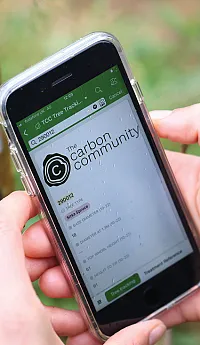
Waring is doing just that as a researcher on an EW experiment in Wales. Spearheaded by The Carbon Community, a non-profit group working to sequester carbon through forestation and management practices, the experiment began in 2021 with the planting of 25,000 trees. Some were planted in soil treated with crushed basalt sourced from a nearby mine.
Enhanced weathering is seen as most promising for agriculture. Equipment used to spread lime and fertilizer can do double duty distributing crushed rock, and the land is very navigable. There’s also plenty of it with 38% of the planet’s land devoted to agriculture, according to United Nations’ statistics. But rangelands and even forests could be suitable, and applying rock dust to soil before reforestation can enhance the trees’ innate carbon-capturing superpowers, Waring says. “This project recognizes that creation of forests is also going to be part of our climate solution,” she explains. “So we lock extra carbon away in wood as well as the carbon that's captured through the enhanced weathering mechanism.”
Covering 11 hectares of former sheep pasture, the project may not capture huge amounts of carbon. But that is not—and should not be—the point at this stage, according to Waring. “It's equally important to understand all the ramifications for different components of the ecosystem,” she says. “We have incredibly few observations of whether that even works ... and we also don't know if there are potential unexpected side effects that could be positive or negative.”

In their experiment, Waring and her colleagues will carefully track any such effects over several decades in addition to measuring and modeling weathering rates. On the plus side, the rocks might provide a nutritional boost to the trees; in the con column, they might accelerate the natural processes that lead to carbon release from soils.
If those venturing into the EW space feel daunted by its complexity, that sounds about right, Waring says. “The enhanced rock weathering story can't be picked apart from the carbon cycling and vegetation, or the carbon cycling in the soil, or the biogeochemistry of streams,” she says. “They all interact with each other.”
While the reforestation project will help determine the future of EW, Waring, “as a scientist and inherently a conservative person,” isn’t placing any bets. “I'm kind of agnostic as to how well it will work,” she says.
But given the high stakes and limited choices on the table, others are pushing their chips toward EW.
 | 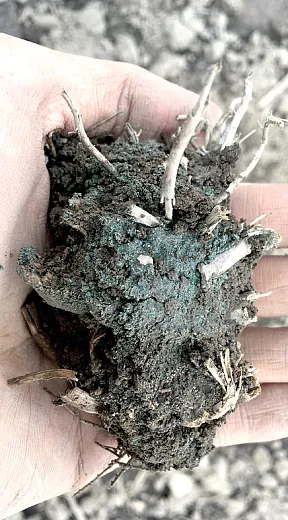 |

New Evidence Converts a Non-Believer
While he may not be ready to wager the farm, so to speak, on EW, Cornell’s Houlton says it’s the best bet currently out there. The technique appears to tick off the three critical CDR boxes, he says: The carbon it captures is above and beyond what can be snagged by other means; its impact can be measured and verified (although those details are still being worked out); and it sequesters carbon in the long term.
“This is the only solution that's in my wheelhouse that, I believe, has the potential to hit the ‘Triple Crown,’ and could actually get carbon out and get farmers paid,” Houlton says. In fact, he shifted his entire program to focusing on the technique: “That's all we do now.”
Houlton was not always a fan. When he began field trials looking at crushed rock in agriculture while at the University of California–Davis, he was, he recalls, a “non-believer.” At the time, Houlton and his team were looking for a way to measure weathering. They came up with what they thought was an elegant idea: Put crushed-up rock in mesh bags, bury them, then dig them back up months or years later. To quantify reactions that had occurred in that period, they measured how much the bag’s mass had changed.
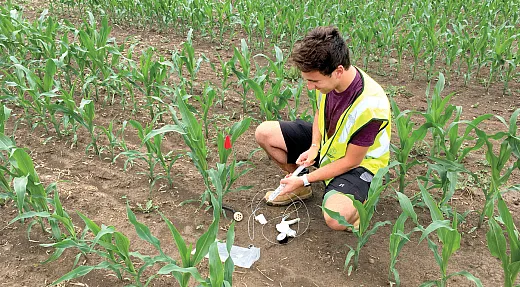
Elegant, perhaps. But it didn't work. So they moved to plan B: After a period of weathering, they took the soil and extracted any partially dissolved carbon that remained loosely bound to it. But, again, the results were underwhelming.
“We found a little bit of evidence there,” Houlton says, “but certainly not the magnitudes anyone was talking about.” Strike two.
Then, grad student Iris Holzer suggested an old-school pivot. Why not try lysimeters? Why not, Houlton agreed. And within a few months of using the devices to collect pore water from their treated soils, the researchers were seeing clear evidence of dissolved carbon. “I was like, ‘OK, it's there. It's happening—it's really happening,’” recalls Houlton, whose team published a paper last
year on their field trials.
In other research presented at the 2021 American Geophysical Union meeting, the team describes how their lysimeter-based methodology is shedding light on EW’s potential. The news is encouraging. “We're finding a doubling of carbon removal within a few months of rock dust addition through this technology,” he says. The findings are especially impressive, he says, because the experiments took place during a severe drought.
“You wouldn't expect this technology to work so well in dry climates,” Houlton says, “and we're finding that, even under really bad conditions, it's working.” As more researchers adopt the technique, evidence for EW will likely grow, Houlton predicts. “You're going to start to see the first large-scale evidence of this technology and its ability to absorb carbon dioxide in the peer-reviewed scientific literature.”
Using plant growth chambers, Houlton’s group has also been investigating how the technique will perform under climate change. “We're finding the technology works better under those future
Enter the Hare
The people behind the carbon removal start-up UNDO will not be waiting.
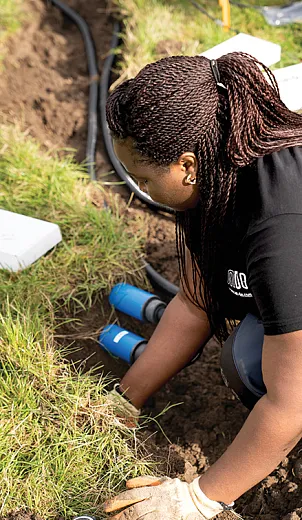
The company’s name refers to undoing, through EW, some of those hundreds of billions of tons of carbon dioxide we’ve released into the atmosphere. The company grew out of The Future Forest Company, a British company that restores native forests in Scotland, earning carbon credits for the incipient woodlands. Its mission is to plant enough trees to remove 1 million metric tons of carbon dioxide from the atmosphere by the end of this decade.
While a laudable goal, it’s a drop in the carbon removal bucket. That realization prompted company officials to face what Peter Olivier, UNDO’s head of new markets, calls a “coming-to-terms moment,” about the project’s scale. “Even if we planted the whole world with forests,” he says, “we still wouldn't get there. We need other levers that we can pull on.” The lever they chose was enhanced weathering.
The technology, the environmental entrepreneurs reasoned, is more scalable and offers better co-benefits than other CDR approaches. With the carbon clock ticking, it also promises relatively fast results. They could leverage a technique nature had already perfected while also tapping into established knowledge, cultures, land use, and people power. The infrastructure for transporting and redistributing vast amounts of rocks was already in place. Most compellingly, Olivier argues, the technique dovetails with existing systems and economies rather than disrupting them.
“It allows people in rural areas—people who may not feel connected to things like direct air capture or feel scared about things like carbon taxes—to participate in and benefit from the growth of the
carbon market,” Olivier says. “And it does not require them to stop being farmers or turn all their fields into solar panel installations.”
Launched in 2022, the start-up has already begun exploiting those advantages. Last year, Olivier says, UNDO applied 24,000 tons of crushed basalt rock on 2,900 acres in Central Scotland and the U.S,. Pacific Northwest. Projections for this year call for hundreds of thousands of tons to be spread across thousands of acres.
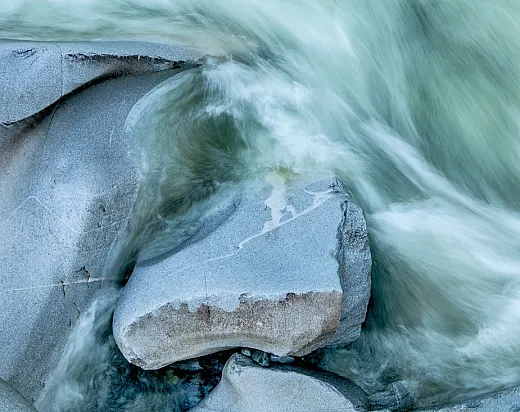
In enhanced rock weathering, rainwater combines with CO2 as it falls, forming carbonic acid. When this dilute acid hits the ground, the CO2 interacts with crushed basalt rock that has been spread on the ground, mineralizes, and is safely stored as solid bicarbonate ions for upwards of 100,000 years. Photo courtesy of UNDO.
If this pace casts UNDO as the hare to Waring’s and Houlton’s tortoises in the CDR story, Olivier seems fine with that, given the immediacy and scale of the challenge. But he’s betting on a different ending than Aesop’s. “If we were to wait 20 years until we understood absolutely everything about this, we almost certainly will miss our window from a carbon perspective,” he says.
With much yet to work out in the science, that pace entails risk. But so do all forms of carbon removal, including reforestation, Olivier says: The well-documented benefits of tree planting could always go up in smoke. It’s unknown exactly how much carbon EW sequesters given various conditions, crops, soils, and climates. But by forging ahead in the knowledge that they are storing some carbon, UNDO and like- minded start-ups can provide more precious data to help scientists answer those questions sooner, Olivier says. UNDO’s geochemists and soil scientists also contribute knowledge to the field in collaboration with academic researchers. And with boots and rocks already on the ground, they can continuously iterate tools and processes. The company has submitted a measurement methodology for certification to the International Organization for Standardization and is working with third-party verifiers like Verra that are developing quality assurance processes for voluntary carbon markets.
If you liken the traditional scientific process to a well-worn, if lengthy road, UNDO might be described as bushwacking a shortcut. The road may get bumpy, but they think they’ll reach the goal sooner. As Olivier puts it, “There is the challenging and perhaps uncomfortable work of deciding that we need to go as fast as we can credibly go.”

A Call for Cooperation and a Plea for Data
Cornell’s Houlton has one word for companies eager to implement CDR techniques before scientists have had their full say: biochar.
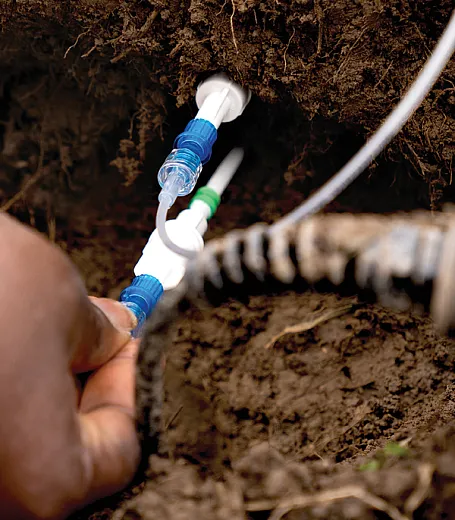
Not that long ago, biochar was the “it” CDR technique. Applied to soils, the charcoal-like, slowly decomposing material can sequester carbon for hundreds or thousands of years. Perhaps due to wishful thinking, biochar was hailed as humanity’s great hope in the fight against climate change, attracting media attention and start-up money. But the hype quickly outpaced the research, setting the science back.
“Biochar was going to be ‘the thing,’” Houlton recalls. “But when it fell short of solving all the problems, it became something that nobody was interested in.” If it ends up as a buzzword, he fears, EW could suffer the same fate.
“The last thing we want is for businesses to be selling carbon that's not really working,” Houlton says. “We need to make sure we don't let the hype and the potential drive the operation.” That’s why Houlton wants to build bridges with business. He is forming a group of scientists and EW start-ups aimed at getting scientific findings to start-ups sooner. While information may not flow freely in the opposite direction—businesses need to protect some secrets from competitors, after all—Houlton hopes cooperation can also keep start-ups tuned in to scientists’ concerns. Olivier emphasizes that UNDO has enormous respect for academic scientists and sees their work in collaboration with theirs.
In the end, data will deliver the answers. Imperial College’s Waring hopes more experts will join her in the scientific trenches.
“We need lots of scientists working on it and delivering data because we are super data limited,” Waring says. “I think within the next decade or so we will start to have a much better idea of the range of carbon uptake values that we might see, the places where it might be best deployed, and how to maximize the potential.”
Dig Deeper
Research Cited in this Article Almaraz, M., Bingham, N.L., Holzer, I.O., Geoghegan, E.K., Goertzen, H., Sohng, J., & Houlton, B.Z. (2022) Methods for determining the CO2 removal capacity of enhanced weathering in agronomic settings. Frontiers in Climate, 4, 970429. https://doi.org/10.3389/fclim.2022.970429
Holzer, I., Nocco, M., Bingham, N., Goertzen, H., & Houlton, B. (2021). Soil carbon sequestration from enhanced weathering during a historic drought year. In AGU Fall Meeting 2021.http://bit.ly/3YS3Tcc
Decode 6
Interested in this topic? Check out Decode 6 (https://decode6.org). Decode 6 posts articles, videos, and podcasts on all things carbon: capture, markets, climate, ecosystem services, and more.
Text © . The authors. CC BY-NC-ND 4.0. Except where otherwise noted, images are subject to copyright. Any reuse without express permission from the copyright owner is prohibited.










